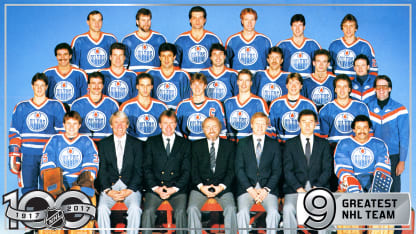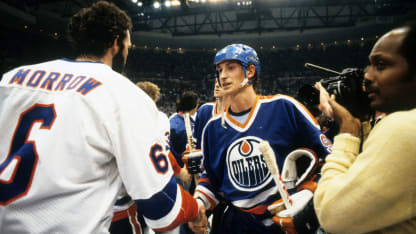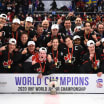By any measure, the 1983-84 Oilers were dominant. They finished first overall with 119 points, 15 more than anyone else. They won the Smythe Division by 37 points and the Campbell Conference by 31. But it's their explosive offense that boosts them into the NHL's Top 10. Assembled by general manager/coach Glen Sather with indispensable input from chief scout Barry Fraser, the Oilers smashed offensive records, then leapfrogged them. In 1983-84, they scored 446 goals, an average of 5.58 per game, records that still stand today. They also set the NHL record for most assists (736, a number they exceeded two years later) and most points scored (1,182, still a record).
1983-84 Edmonton Oilers roster
"We were just so strong offensively in the early '80s," Gretzky, their captain, told NHL.com. "That was our forte as a team. Glen wanted us to win 6-5 and 7-6."
And they often did. The 1983-84 Oilers were the first team with three 50-goal scorers: Gretzky (87), linemate Jari Kurri (52) and Glenn Anderson (54). Defenseman Paul Coffey's 40 allowed them to tie the record of four 40-goal scorers they set in 1982-83. The Oilers also tied the NHL record of four 100-point scorers, with Gretzky (205) topping 200 points for the second time and winning his fourth Art Ross Trophy to go with his fifth Hart Trophy.
RELATED: Top 10 Greatest NHL Teams
Gretzky also had a 51-game point streak, still the NHL record, as is his 1.18 goals-per-game average. Edmonton was even dangerous when playing down a man: The Oilers' 36 shorthanded goals are still the single-season NHL record.
The Oilers jumped onto everybody's radar even before joining the NHL. They were still in the World Hockey Association when they acquired Gretzky, a skinny 17-year-old from the Indianapolis Racers on Nov. 2, 1978.
"I was a kid, 17 years old, 145 pounds, I had just been traded and scared to death," he said. "I walked into Glen's office and he told me he wanted me to come live with him, which I did. He said, 'In September, we're going to be in the National Hockey League. One day, you're going to be captain of this team and you're going to lift the Stanley Cup.' I'm 17 and I'm thinking, 'OK, that sounds good to me.'"



















